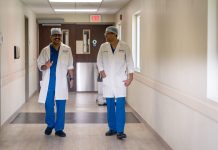The effects of advancing technology on society as we enter the third decade of the new millennium is as apparent in traumatic injuries as much as anywhere.
Twenty years ago, driving while intoxicated was a major cause of motor vehicle related trauma and associated long-term injuries to patients. With the efforts of groups such as M.A.D.D (Mothers Against Drunk Driving) the rate of injuries caused by driving while intoxicated has decreased.
Unfortunately, another phenomenon, thanks to technological advances, has rapidly arisen to take its place. Distracted driving, such as talking or texting while driving, has replaced drunk driving as a major cause of vehicle-related injuries.
New work has been done on the effects of talking or texting while driving, and this shows the risk of crashing increases up to 23 times in those who use their phone while driving, mimicking the effects of driving while intoxicated.
Governments around the world are grappling to bring distracted driving under control, with increasing fines and loss of driving privileges, but as can be seen daily, many people still actively use their phone while driving.
The injuries from distracted driving that health professionals see are usually high energy, meaning the damage to the person is extensive, especially in the case of vehicle versus pedestrian. Injuries from distracted driving are entirely preventable – just don’t do it.
The energy of an accident can predict how severe an injury a person sustains. Low energy injuries happen from things like tripping and falling and result in simple patterns of fracture that are often treated with things like casts or braces.
High energy injuries, such as those from distracted driving, result in more complex fracture patterns, often with injuries to surrounding muscles and nerve. These complex high energy injuries more often require a surgery to ensure the person’s function is maintained.
Bone health
Good bone health is another factor that comes into play when dealing with traumatic injuries. Exercise, especially weight training, calcium, vitamin D and a healthy diet all play a role in developing healthy bones. As we grow, we increase the strength of our bones until around age 25, with bone strength decreasing thereafter.
If we do not build good bone strength by age 25, we cannot catch up and are at higher risk of developing weak bones as we age, called osteopenia or osteoporosis depending on the severity.
The weaker the bone, the higher the risk that it breaks under low energy conditions, often with patterns mimicking high energy injuries from a low energy fall. These high energy patterns can require operative intervention, often of a more complex type than would be needed in someone with good bone health.
Poor diet and lack of exercise at a young age has significant and potentially severe bone health consequences. The increasing prevalence of indoor, sedentary activities in our youth, with a poor diet, combine to have lifelong effects on bone strength and fracture risk.
Educational institutions are increasingly recognising the importance of prescribed exercise in the young, as are physicians who often now give physical exercise ‘prescriptions’ rather than the standard medication prescriptions.
Distracted driving and bone health are good examples of the marked benefits of ‘preventative medicine’. It is far easier to prevent an injury or disease than treat it, far healthier for the patient and far cheaper the health care system.
Education is the key to preventative medicine, teaching (mostly) young people about the effects of their health and lifestyle choices is key. As simple as it sounds, enacting change around cell phone use and lifestyle choices is about as difficult as it gets for society level change.
Dr. Dale Williams is an orthopaedic surgeon with Cayman Orthopaedic Group.








